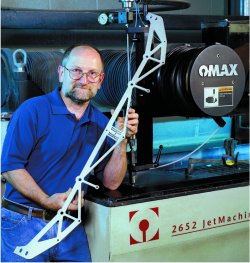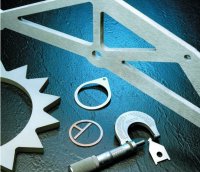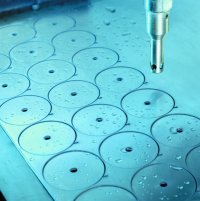|
As the volume of prototype work increased, this versatile company stopped whittling parts by hand and settled on waterjet technology for a more efficient — and higher profit — alternative.
This broad-based business model has helped LMS grow dramatically in the last two years with the addition of new waterjet machinery that can handle “basically whatever we throw at it in the area of prototyping,” according to Charnegie. At LMS, located not far from the railroad tracks along the Lehigh River’s north shore, a telephone rings persistently as the machine shop keeps running at full throttle. With so much activity going on now, you would never guess that the pace at LMS Stamping has not always been so brisk. “When LMS started in 1987, it was just a room full of equipment looking for work,” Charnegie recalls. The company had begun with stamping presses ranging from 10 to 400 tons, a CNC (computer numerical control) milling machine, surface grinders, and other basic machine tools. Over the years, LMS has moved to doing prototype work, because it is both profitable and challenging. “That’s where our specialty lies,” says Charnegie. “We have a lot of customers who come to us with prototype parts. Many aren’t even sure if the drawing they have is their final design. In addition, with the price for hard tooling running upwards of $10,000 or more, they would prefer to make an inexpensive prototype first. “Just the other day,” he recalls, “the folks from ‘Just Born Candies,’ the people who make ‘Peeps,’ came to us needing some little pumpkin-face dies. They were getting ready for the Halloween season and were shifting over from bunnies and chickens to marshmallow pumpkins.” After ghost-and-goblin season, ‘Just Born Candies’ came back to LMS, and the shop delivered Christmas tree dies for the holidays.
“We use a lot of sensor technology here with fully automated dies,” he points out. “We monitor cutoff, stroke, part ejection, and take photographs of the die’s movement. If something’s not in position before the die comes all the way down, the process will stop, protecting valuable tooling. A while back, Harley Davidson had a new die they couldn’t run. We brought it in here, set it up, and got it running, then sent it back with proper setup instructions.” Plasma and Laser Cutters Fail to Measure Up In their search for machining alternatives, Charnegie says, “We started off looking at high-definition plasma cutters, but found that when they cut — especially stainless — they created dross and a hardened edge along the part. Overall, it produced a lower-quality finish than we needed. “When it comes to lasers, the first thing that’s hard to swallow is the half-million dollar cost,” he continues. “However, even if cost weren’t a consideration, lasers at that time couldn’t cut more than 3/8" thick stainless steel. They also had a hard time with aluminum and brass because of reflectivity; and, what they did cut often featured heat-affected zones. Since these are the main metals we cut, we had to eliminate lasers as an alternative.”
If a customer needs less than 1,000 parts, LMS nearly always uses the OMAX. “In a case like that, there’s just no sense in making a die,” says Charnegie. LMS also uses the abrasive waterjet for in-house die parts like bridge strippers and blank holders. “Instead of waiting three days for an outside tool and die shop to replace a broken bridge stripper,” he says, “we draw it up, cut it out, and we’re back in operation in an hour.” Charnegie has been surprised by the broad variety of applications that the machine can handle. “We began using it for secondary operations as well,” he says. “After blanking a part, we use the abrasive waterjet to make part nests to hold the part for secondary operations. We also have cut nests to use in the waterjet. The waterjet can cut any shape without the need for special punches or dies. “The abrasive waterjet also is excellent for parts that have to be perfectly flat,” he points out. “It allows us to cut contours like nothing else. It also allows us to place holes closer to the material’s edge than could be punched. We’ve even used it to help customers who need operations not related to stamping, such as cutting holes and patterns in end plates and valve bodies. “In one day, there’ll be 20 different parts that will go through that machine: fixtures, pipe flanges, even tweezers for the electronic industry,” reports Charnegie. One of these unique jobs was a metal “clip” connecting underground gasoline storage tanks with aboveground pumps at gasoline stations. The customer did not know the exact connection angle needed, so a die at this stage was out of the question. Instead, LMS made a few parts for the customer to try in the field. Working with the customer, LMS was able to make changes until the clip was a perfect fit. At that point, LMS actually built the hard tooling. An unexpected source of work has been from inspection companies. “For example, we’ve used the OMAX JetMachining Center to cut camshafts in half, thereby enabling our customer to inspect internal components for stress cracks,” says Charnegie. “We’ve had several different jobs like that. We’ve also cut marble, tile, and glass with great success.” LMS may soon buy a second, larger OMAX JetMachining Center and pump, he states. “When we bought the first abrasive waterjet,” he says, “we were concerned about not having enough work to keep it busy; but, it wasn’t long before it was running like it has ever since: all day, every day.” OMAX Corporation - November 2000 |
 “You name it, we can make it.” That is what Sam Charnegie, Operations Manager of LMS Stamping (Bethlehem, PA), is fond of saying. From harness guide bars for people who race Corvettes, to flanges for railings for buses and rail cars, to catsup and mustard dispensers for stadiums, LMS customers have a need and the shop can deliver it efficiently and quickly.
“You name it, we can make it.” That is what Sam Charnegie, Operations Manager of LMS Stamping (Bethlehem, PA), is fond of saying. From harness guide bars for people who race Corvettes, to flanges for railings for buses and rail cars, to catsup and mustard dispensers for stadiums, LMS customers have a need and the shop can deliver it efficiently and quickly. “Really, there’s no end to the variety,” Charnegie explains. “Any machine shop can make one of anything. The question is, can you efficiently make two the same?” LMS makes parts for a huge variety of local and national companies, particularly in the aftermarket automotive and architectural hardware industries. In addition to short-run stamping of stainless, brass, and aluminum parts, LMS does a considerable amount of die setup work.
“Really, there’s no end to the variety,” Charnegie explains. “Any machine shop can make one of anything. The question is, can you efficiently make two the same?” LMS makes parts for a huge variety of local and national companies, particularly in the aftermarket automotive and architectural hardware industries. In addition to short-run stamping of stainless, brass, and aluminum parts, LMS does a considerable amount of die setup work. Charnegie became sold on waterjet technology — specifically an OMAX JetMachining® Center — when he took a drawing along on a disk to a demonstration. He handed his disk to the operator, and three minutes later held a finished part in his hand. He recalls, “All we could say was, ‘That’s our machine!’ We looked around a little more, but found that OMAX was the only company offering such a simple, easy-to-use controller that could work straight from a .DXF (digital exchange format) file. We can take a regular guy off the floor, put him on the waterjet; and, within an hour, he can cut top-quality parts. There’s hardly any training needed.”
Charnegie became sold on waterjet technology — specifically an OMAX JetMachining® Center — when he took a drawing along on a disk to a demonstration. He handed his disk to the operator, and three minutes later held a finished part in his hand. He recalls, “All we could say was, ‘That’s our machine!’ We looked around a little more, but found that OMAX was the only company offering such a simple, easy-to-use controller that could work straight from a .DXF (digital exchange format) file. We can take a regular guy off the floor, put him on the waterjet; and, within an hour, he can cut top-quality parts. There’s hardly any training needed.”